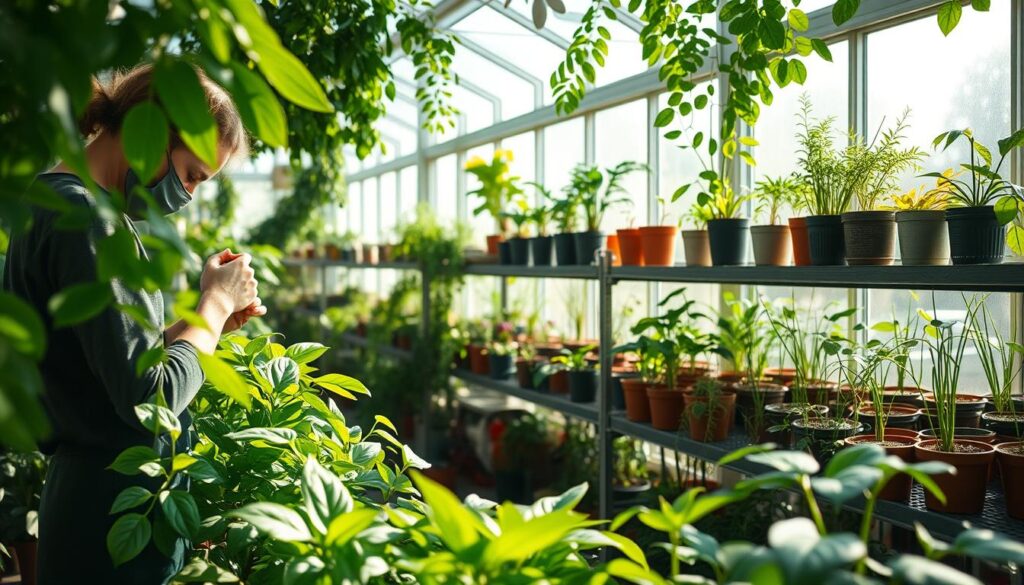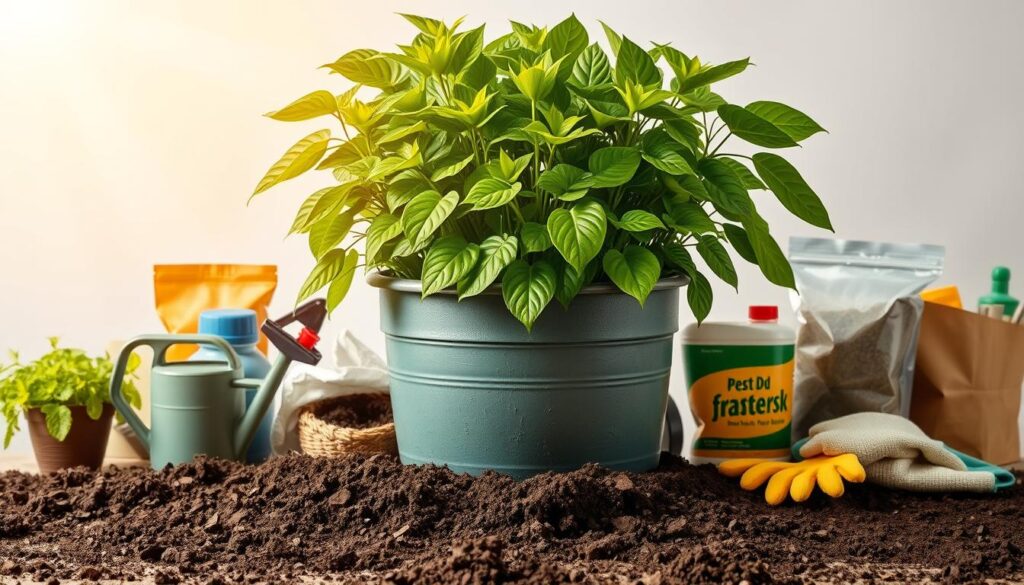Expert Plant Maintenance Tips for Growth

About the Game
Keeping plants healthy is key to their growth and your happiness. This guide gives top advice on taking care of plants. It highlights the important parts of plant care and how to make them grow well. By knowing and providing what your plants need like light, water, and soil, you can make them thrive in your space. We’ll show how to make your plants do more than just stay alive.
Understanding Plant Needs for Optimal Growth
For plants to grow well, we must know what they need. Light, water, and good soil are key. Giving them the right amount makes plants healthy and colorful.
Light helps plants make food through photosynthesis. They do best in bright, but not direct, light. Too little light can stop them from growing, so check your light at home or outside.
Anúncios
Water is crucial for plant health. Too much or too little can harm them. A regular watering plan that fits your plants keeps them happy.
Plants need good soil and food to grow strong. Soil full of nutrients gives them what they need. Check and fix soil nutrients often for healthy plants.
Anúncios

Choosing the Right Plants for Your Environment
Choosing the right plants for where you live is crucial for their growth and health. The amount of light inside your home or office is key to picking the best plants. For low-light areas like north-facing windows, snake plants or pothos are great. Meanwhile, bright, south-facing windows are perfect for plants that love sunlight, such as succulents and cacti.
It’s important to know which plants go well together when you’re adding new ones to your space. Some plants need the same care, but others might not do well together because they need different amounts of light and water. Think about your daily habits and how much time you can give to your plants. Choose plants that fit your lifestyle so you can enjoy having plants around without too much work.
Essential Plant Maintenance Techniques
Taking care of plants the right way ensures they grow strong and look beautiful. Learning the correct methods for watering and providing the right amount of light will make your gardening more enjoyable. These elements are key for keeping plants healthy and need careful attention for best results.
Watering Practices for Healthy Plants
How you water your plants makes a huge difference in their health. Since different plants need different amounts of water, understanding when to water is essential. Soil moisture and the time of year also influence how often you should water them.
During colder months, most plants need water less often. Using a moisture meter is a smart way to check the soil. This lets you water your plants just right, based on what they need.
Light Requirements Based on Plant Types
Light is just as crucial as water for keeping plants healthy. Every plant needs a certain amount of sunlight to be healthy. Not getting enough light can cause problems like leaves turning yellow or plants not growing properly.
Some plants need lots of sunlight, while others do better in the shade. It’s important to know what your plant needs. Moving your plant to get the right amount of light, especially as seasons change, keeps it healthy.
Soil Selection and Potting Tips
The right soil choice is key to plant health. It provides nutrients and drains well, keeping moisture levels balanced. Special mixes are needed for plants like succulents, preventing too much water retention.
Choose pots with drainage holes to avoid root problems. Drainage holes let extra water flow out. Repot plants every 12-18 months for fresh, nutrient-rich soil and better drainage, creating a perfect environment.
Humidity and Temperature Management for Plant Health
Both humidity and temperature are key for plants to be healthy. Most indoor plants do best when the air is 40-50% humid. Keeping humidity at this level helps plants grow well and reduces stress. There are various ways to increase humidity and keep the temperature just right for your indoor garden.
Increasing Humidity with Simple Techniques
Putting plants together can create a mini environment that’s more humid. This is good for plants that need extra moisture. Some other ways include:
- Using hydroponic misters to add moisture to the air.
- Placing pebble trays with water under pots to increase humidity through evaporation.
- Spraying the leaves often to keep them at the right humidity.
Controlling temperature is also critical. Indoor plants usually like being in 65 to 85 degrees Fahrenheit. Keeping plants in this temperature range helps them grow and avoids stress. To keep plants healthy, avoid placing them in drafty spots and make sure their environment is stable.
Common Plant Care Mistakes to Avoid
Many folks who love plants often make mistakes that hinder their growth. Overwatering and underwatering are big problems in indoor gardening. Knowing about these mistakes can make your plants healthier and stronger.
Risks of Overwatering and Underwatering
Overwatering is a mistake many plant caregivers make. It can lead to root rot and various fungal issues. If your plant leaves turn yellow and the soil smells musty, you might be overwatering. Watching how much you water your plants can stop this issue.
Not giving your plants enough water is harmful too. Dry, wilted leaves are signs your plants need more water. Using moisture meters and checking the soil help in giving your plants the right amount of water. This way, you can water your plants when they really need it.
It’s key to change how you care for your plants with the seasons. Knowing what each plant needs prevents common care mistakes. This leads to plants that thrive and are healthy.
The Role of Fertilization in Plant Maintenance
Fertilizing plants is key to their strong growth. It gives them the nutrients they need to be healthy and productive. Knowing when and how much to fertilize is important. Different plants need different nutrients at various stages.
In spring and summer, plants need more food. Using a weaker fertilizer mix can prevent harm like root burn. It’s important not to overdo it. When it’s colder, it’s often best to cut back or stop fertilizing. This matches plants’ natural rest period.
To sum it up, good plant growth needs careful feeding and nutrient management. By choosing the right fertilizer and amount for each plant, you can grow healthy, beautiful plants.
Monitoring and Managing Plant Pests
Having plants indoors makes your space beautiful and joyful. But, sometimes, it can bring in pests like aphids, spider mites, and mealybugs. To keep your indoor garden healthy, it’s key to spot these pests early and know how to deal with them.
Identifying Common Indoor Plant Pests
Checking your plants often helps you catch pests before they spread. Look under leaves where bugs like to hide. Yellow leaves, webbing, or sticky stuff can mean pests are there. Acting fast helps stop a small problem from getting worse.
Try natural methods first to get rid of pests. Neem oil can both repel and kill various pests. Insecticidal soap is great for taking care of soft-bodied insects. By staying alert and taking action early, you can protect your plants and keep them healthy.
Reputation Matters: Shopping for Healthy Plants
When looking for healthy plants, it’s important to get them from trusted places. Local garden centers and specialty stores usually have healthier plants than big stores. These places focus on quality, making sure their plants are well cared for before you take them home.
Be careful when checking out plants. Look for signs they’re not doing well, like yellow leaves or droopy stems. Spotting these signs early helps you avoid buying plants that won’t do well with you.
For the best shopping experience, go to stores with knowledgeable staff. They can give you great advice on how to care for your plants. With their help, you can pick plants that will flourish in your space.
The Importance of Regular Repotting
Repotting is key for keeping plants healthy and encouraging them to grow well. It’s best to repot plants every 12 to 18 months. This helps them get new nutrients and room for their roots to grow.
Look for roots coming out of the pot’s holes or if the plant stops growing. These signs mean it’s time to repot.
Choose a new pot that’s a bit bigger than the old one. This will help the plant grow without its roots getting too crowded. Make sure the new pot has good drainage. Following these steps will help your plants stay healthy and grow better.
Tailoring Your Plant Care to Fit Your Lifestyle
Changing the way you care for plants to fit your life can make both you and your plants happier. For those who are always busy, picking plants that don’t need much care is smart. ZZ plants and snake plants are great because they don’t need much from you but still add beauty to your space.
If you have more free time, you might like plants that need more care, like orchids. Knowing your daily routine helps you pick plants that will grow well in your home. Matching your lifestyle to the right plants makes your indoor garden a peaceful place.
Think about these points when choosing plants:
- Assess the amount of natural light your space receives.
- Evaluate how often you can dedicate time to plant care.
- Choose plants that can adapt to varying humidity levels.
Conclusion
To have healthy plants, knowing how to care for them is key. Choosing plants that fit with the light and care they need is the first step. Tips on watering, picking the right soil, and keeping pests away help your plants grow strong.
Also, plants do better when you feed them regularly and adjust how you care for them to match your daily life. Following these tips can make your indoor garden vibrant and give you a fun hobby.
When you find the right balance in taking care of your plants, they will flourish. This means your home will be filled with beautiful greenery. By staying dedicated, you’ll enjoy a successful journey in caring for your plants.
FAQ
What are the most essential factors for plant growth?
How can I tell if my plant is getting enough water?
What type of soil should I use for my plants?
How can I increase humidity for my indoor plants?
What are the signs of overwatering my plants?
When should I fertilize my plants?
What precautions should I take when buying plants?
How can I tell when my plants need repotting?
How do I choose plants that fit my lifestyle?
Game Details
No
No